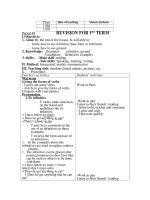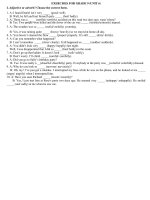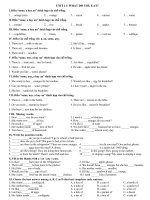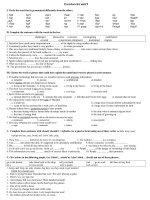Tài liệu Slides for ZOSTAVAX docx
Bạn đang xem bản rút gọn của tài liệu. Xem và tải ngay bản đầy đủ của tài liệu tại đây (185.61 KB, 23 trang )
1
1
ZOSTAVAX
®
[Zoster Vaccine Live (Oka/Merck)]
Approved by the Food and Drug
Administration on May 25, 2006
2
2
Description
• Lyophilized preparation of the Oka/Merck strain of live,
attenuated VZV.
• Each 0.65-mL dose contains a minimum of 19,400 plaque-
forming units (PFU).
• Each dose also contains sucrose, hydrolyzed porcine
gelatin, sodium chloride, monosodium L-glutamate, sodium
phosphate dibasic, potassium phosphate monobasic, and
potassium chloride; residual components of MRC-5 cells,
including DNA and protein, and trace quantities of neomycin
and bovine calf serum.
• Contains no preservatives.
Description
• ZOSTAVAX
®
[Zoster Vaccine Live (Oka/Merck)] is a lyophilized preparation
of the Oka/Merck strain of live, attenuated VZV.
• Each 0.65-mL dose of the vaccine contains a minimum of 19,400 plaque-forming
units (PFU) of attenuated virus.
• Each dose also contains sucrose, hydrolyzed porcine gelatin, sodium chloride,
monosodium L-glutamate, sodium phosphate dibasic, potassium phosphate
monobasic, and potassium chloride; residual components of MRC-5 cells, including
DNA and protein, and trace quantities of neomycin and bovine
calf serum.
• The product does not contain preservatives.
3
3
Indications and Usage
• ZOSTAVAX is indicated for the prevention of herpes zoster
(shingles) in individuals 60 years of age and older.
• ZOSTAVAX is not indicated for the treatment of
zoster or postherpetic neuralgia.
Indications and Usage
• ZOSTAVAX
®
[Zoster Vaccine Live (Oka/Merck)] is indicated for the prevention of
herpes zoster (or shingles) in individuals 60 years of age and older.
• ZOSTAVAX is not indicated for the treatment of zoster or postherpetic neuralgia.
4
4
Contraindications
• ZOSTAVAX should not be administered to individuals:
– With a history of anaphylactic/anaphylactoid reaction to gelatin,
neomycin, or any other component of the vaccine (see WARNINGS).
– With a history of primary or acquired immunodeficiency states
including leukemia; lymphomas of any type, or other malignant
neoplasms affecting the bone marrow or lymphatic system;
or AIDS or other clinical manifestations of infection with human
immunodeficiency viruses (see WARNINGS).
– On immunosuppressive therapy, including high-dose corticosteroids.
– With active untreated tuberculosis.
– Who are or may be pregnant (see PRECAUTIONS, Pregnancy).
Contraindications
ZOSTAVAX
®
[Zoster Vaccine Live (Oka/Merck)] is contraindicated in individuals who:
• Have a history of anaphylactic/anaphylactoid reaction to gelatin, neomycin, or any
other component of the vaccine (see WARNINGS).
• Have a history of primary or acquired immunodeficiency states including leukemia;
lymphomas of any type, or other malignant neoplasms affecting the bone marrow or
lymphatic system; or AIDS or other clinical manifestations of infection with human
immunodeficiency viruses (see WARNINGS).
• Are on immunosuppressive therapy, including high-dose corticosteroids.
• Have active untreated tuberculosis.
• Are or may be pregnant. (Please refer to PRECAUTIONS, Pregnancy in the
Prescribing Information.)
5
5
Clinical Pharmacology:
The Shingles Prevention Study Design
Oxman MN, Levin MJ, Johnson GR, et al. N Engl J Med. 2005;352:2271–2284.
Subjects Enrolled
N=38,546
Age 60 to 69 years
n=20,747
Age ≥70 years
n=17,799
Zoster vaccine
n=10,378
Placebo
n=10,369
Zoster vaccine
n=8,892
Placebo
n=8,907
Adverse Event
(AE) Substudy
n=6,616
Immunogenicity
Substudy
n=1,395
Clinical Pharmacology: The Shingles Prevention Study Design
• The Shingles Prevention Study was a placebo-controlled, randomized, double-blind
study.
1
• The study enrolled a total of 38,546 subjects who were 60 years of age or older.
1
• Randomization was stratified by age
1
:
– 60 to 69 years of age
– ≥70 years of age
• Subjects were randomized to receive either a single dose of zoster vaccine (n=19,270)
or placebo (n=19,276).
1
• The median follow-up of the study was 3.1 years (range 31 days to 4.9 years).
• The study excluded people who were immunocompromised or using corticosteroids on
a regular basis, anyone with a previous history of HZ, and
those with conditions that might interfere with study evaluations, including people with
cognitive impairment, severe hearing loss, those who were non-ambulatory and those
whose survival was not considered to be at least 5 years.
• The clinical trial included 2 substudies
1
:
– The Adverse Event (AE) Monitoring Substudy, which comprised
6,616 subjects.
– An immunogenicity substudy, which comprised 1,395 subjects.
• Zoster cases were confirmed by polymerase chain reaction (93%), viral
culture (1%), or in the absence of viral detection, by the Clinical Evaluation Committee
(6%).
• Individuals in both vaccination groups who developed zoster were given famciclovir
and, as necessary, pain medications.
1
Reference:
1. Oxman MN, Levin MJ, Johnson GR, et al. A vaccine to prevent herpes zoster and postherpetic neuralgia in older adults.
N Engl J Med. 2005;352:2271–2284.
6
6
Patient Demographics in the
Shingles Prevention Study
227 (1.2)217 (1.1)Other or unknown
248 (1.3)265 (1.4)Hispanic
420 (2.2)395 (2.0)Black
18,381 (95.4)18,393 (95.4)White
Race n (%)
7,919 (41.1)7,867 (40.8)Female
11,357 (58.9)11,403 (59.2)Male
Gender n (%)
8,907 (46.2)8,892 (46.1)
≥70 years
10,369 (53.8)10,378 (53.9)60 to 69 years
Age n (%)
Placebo Group
N=19,276
Vaccine Group
N=19,270Characteristic
Oxman MN, Levin MJ, Johnson GR, et al. N Engl J Med. 2005;352:2271–2284.
Patient Demographics in the Shingles Prevention Study
• Baseline patient characteristics were similar in both vaccination groups
in the Shingles Prevention Study.
1
– The age distribution of enrolled patients was 59 to 99 years in
both groups.
– The gender distribution was 59% male and 41% female.
1
– The racial distribution of white (95%), black (2%), Hispanic (1%), and other
(1%) was also similar in both groups.
1
Reference:
1. Oxman MN, Levin MJ, Johnson GR, et al. A vaccine to prevent herpes zoster and postherpetic neuralgia in older adults.
N Engl J Med. 2005;352:2271–2284.
7
7
Prevention of Herpes Zoster
Number of zoster cases
Age (years)
–64%
(95% CI: 56%, 71%)
–41%
(95% CI: 28%, 52%)
–18%
(95% CI: –29%, 48%)
315
122
156
47
261
334
642
37
0
100
200
300
400
500
600
700
Overall
60–69 70–79 ≥80
Placebo
ZOSTAVAX
–51%
(95% CI: 44%, 58%)
Incidence rate of zoster per 1,000 person-years
11.1 10.8 11.4 12.25.4 3.9 6.7 9.9
Prevention of Herpes Zoster
• ZOSTAVAX
®
[Zoster Vaccine Live (Oka/Merck)] significantly reduced the risk of
developing zoster compared with placebo*: 315/19,254 cases (5.4 cases per 1,000
person-years) vs 642/19,247 cases [11.1 cases per 1,000 person-years]). The
protective efficacy was 51% (95% CI: 44%, 58%).
1
– Vaccine efficacy for the prevention of zoster was highest for those subjects
60 to 69 years of age and declined with increasing age.
– ZOSTAVAX reduced the incidence of zoster by 64% in individuals
60 to 69 years of age (ZOSTAVAX, n=10,370; placebo, n=10,356);
by 41% in individuals 70 to 79 years of age (ZOSTAVAX, n=7,621; placebo,
n=7,559); and by 18% in individuals 80 years of age or
older (ZOSTAVAX, n=1,263; placebo, n=1,332).
• As with any vaccine, vaccination with ZOSTAVAX may not result in protection
of all vaccine recipients.
• The duration of protection after vaccination with ZOSTAVAX is unknown. In the
Shingles Prevention Study, protection from zoster was demonstrated through 4
years of follow-up. The need for revaccination has not been defined.
*Primary analysis was performed on the modified intent-to-treat (MITT) population that
included all randomized patients who were followed for at least 30 days postvaccination and
did not develop an evaluable case of zoster within the first 30 days postvaccination.
Reference:
1. Oxman MN, Levin MJ, Johnson GR, et al. A vaccine to prevent herpes zoster and postherpetic neuralgia in older adults.
N Engl J Med. 2005;352:2271–2284.
8
8
Postherpetic Neuralgia* in the
Shingles Prevention Study
*Zoster-associated pain rated as ≥3 on a 10-pt scale and occurring or persisting at least 90 days after rash onset.
**Age-adjusted estimate based on the age strata (60–69 and ≥70 years of age) at randomization.
0
Overall 60–69 70–79 ≥80
Age (years)
Number of PHN Cases
80 23 45 1227 8 12 7
25.5
8.6
6.6
7.7
18.9
17.2
6.9
12.5
10
20
30
40
50
% of HZ Cases
With Postherpetic Neuralgia
–5%
(95% CI: –107%, 56%)
–55%
(95% CI: 18%, 76%)
–26%
(95% CI: –69%, 68%)
–39%**
(95% CI: 7%, 59%)
Placebo
ZOSTAVAX
Number of HZ Cases
642 334 261 47315
122
156 37
Postherpetic Neuralgia in the Shingles Prevention Study
• Postherpetic neuralgia was defined as zoster-associated pain (rated as ≥3 on a 10-
point scale by the patient) occurring or persisting at least 90 days following the
onset of rash in evaluable cases of zoster.
• Overall, the benefit of ZOSTAVAX
®
[Zoster Vaccine Live (Oka/Merck)] in the
prevention of postherpetic neuralgia can be primarily attributed to the effect of the
vaccine on the prevention of zoster. Vaccination with ZOSTAVAX reduced the
incidence of postherpetic neuralgia in individuals 70 years of age and older who
developed zoster postvaccination.
• Following completion of the Shingles Prevention Study, a separate analysis was
conducted to evaluate the reduction in PHN in the group of individuals who have
been vaccinated with ZOSTAVAX, but who had developed zoster. In the analysis,
the overall efficacy of ZOSTAVAX for reduction of postherpetic neuralgia in patients
who developed zoster following vaccination was 39% (95% CI: 7%, 59%). This is an
age-adjusted estimate calculated based on the age strata of 60 to 69 and 70 years
of age and older at randomization.
• The vaccine efficacy against postherpetic neuralgia in patients who developed
zoster following vaccination was 5% (95% CI: –107%, 56%) in patients 60 to 69
years of age; 55% (95% CI: 18%, 76%) in patients 70 to 79 years of age: and 26%
(95% CI: –69%, 68%) in patients 80 years of age and older.
9
9
12
57
9
12
69
9
11
7
310
(n = 659)
% Among
Zoster Cases
% Among
Zoster Cases
( n = 321)
7
24
2
5
35
2
5
3
135
1.40.6Impaired Vision
47.042.1Allodynia
1.10.9Bacterial Superinfection
1.71.6Dissemination
10.510.9Ophthalmic Zoster
1.81.6Peripheral Nerve Palsies (motor)
1.40.6Ptosis
8.67.5Scarring
1.82.2Sensory Loss
Placebo
(N = 19,276)
ZOSTAVAX
(N = 19,270)
Complication
N=number of subjects randomized
n=number of zoster cases, including those cases occurring within 30 days postvaccination, with these data available
*Complications reported at a frequency of ≥1% in at least one vaccination group among patients with zoster.
Specific Complications* of Zoster Among
HZ Cases in the Shingles Prevention Study
Specific Complications of Zoster Among HZ Cases in the Shingles Prevention
Study
• The table shows the number of patients with specific complications of zoster among
zoster cases that were reported in the Shingles Prevention Study at a frequency of
≥1% in at least one vaccination group among subjects with zoster.
– The number of zoster cases included the cases that developed within 30
days after vaccination.
• Prespecified zoster-related complications were reported less frequently in subjects
who received ZOSTAVAX
®
[Zoster Vaccine Live (Oka/Merck)] compared to subjects
who received placebo.
• Among HZ cases, zoster-related complications were reported at similar rates in both
vaccination groups.
• Visceral complications reported by fewer than 1% of subjects with zoster included 3
cases of pneumonitis and 1 case of hepatitis in the placebo group, and 1 case of
meningoencephalitis in the vaccine group.









